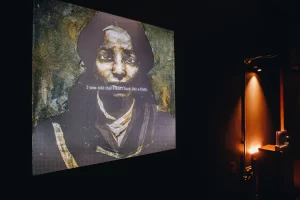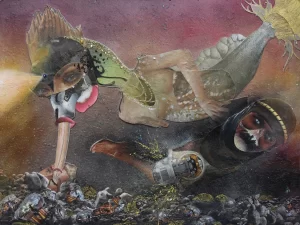Tsuktiben Jamir
A digital exhibition titled ‘Coasting the Topography of South Asian Futurisms’ is currently live on Hyperallergic, curated by Sadaf Padder. This is an effort to bring together contemporary artists, activists and thinkers in an attempt to explore the future of South Asia through a collection of putative and hypothetical pieces of fiction, art and essays. At the same time, it is also an exploration of the individual artist or writer’s own idea of the future.
The themes and concepts discussed in the collection range from identity and politics to climate change and technology, which will include works from artists, scholars and writers from across South Asia, like Pakistan, Bangladesh, India and Sri Lanka. Through the works of this collection, it is Padder’s desire to stray from the notions of the future through Western narratives and instead portray the unique, versatile and intricate imaginations of the future by the artists and scholars of South Asia itself. It is also her hope that this encourages people to dabble with the thought of the future and its entourage of possibilities as well as challenges.

Courtesy: Hyperallergic
Sadaf Padder writes in Hyperallergic about the show, “The need for cultivating more expansive and loving frameworks for futurism becomes more urgent by the day. We are in the midst of a sharp rise in religious fanaticism, caste-oppression, and ethnonationalism that harms over a billion and a half people in the Indian subcontinent and across the diaspora. These tensions are exacerbated by the Indian Citizenship Amendment Act of 2019, a set of oppressions that bleed across 29 states, 8 union territories, neighboring countries and the global diaspora — which numbers over 5.4 million in the United States alone.
This exhibition aims to map a topography of South Asian futurisms, and render the visible multiple strategies used by artists to adapt and develop new futurisms, including Dalit futurism, Subaltern futurism, Queer Muslim futurism, eco-futurism and Sufi Sci-Fi futurism.”
In this project, Padder wants to envision all of humanity as one, without any sort of boundaries or distinction; she writes, “The futuristic framework I propose is transnational, trans-religious, intersectional, classless, caste-free, feminist, and queer.” She continues that in order for us to imagine the future of South Asia, we cannot ignore our past and its components that somehow has seeped into the present and continue to exist; such components like caste supremacy which strives in the United States as well. This caste supremacy is not limited to Hinduism as was made evident through Thenmozhi Soundararajan’s extensive research. Thenmozhi is the author of ‘Trauma of Caste: A Dalit Feminist Meditation on Survivorship, Healing, and Abolition.’ She is also the founder of a civil rights organisation led by Dalits called ‘Equality Labs.’

Courtesy: Hyperallergic
This digital exhibition is sure to be an eye-opener into the dynamics of the society as well as thought-provoking at the same time.
Padder says, “I seek a constructive, open-ended, and mutable framework of South Asian futurisms spacious enough to encompass the subaltern narratives of caste-oppressed and religiously marginalized communities. I do not have all the answers, but I do have a growing trove of questions.”





